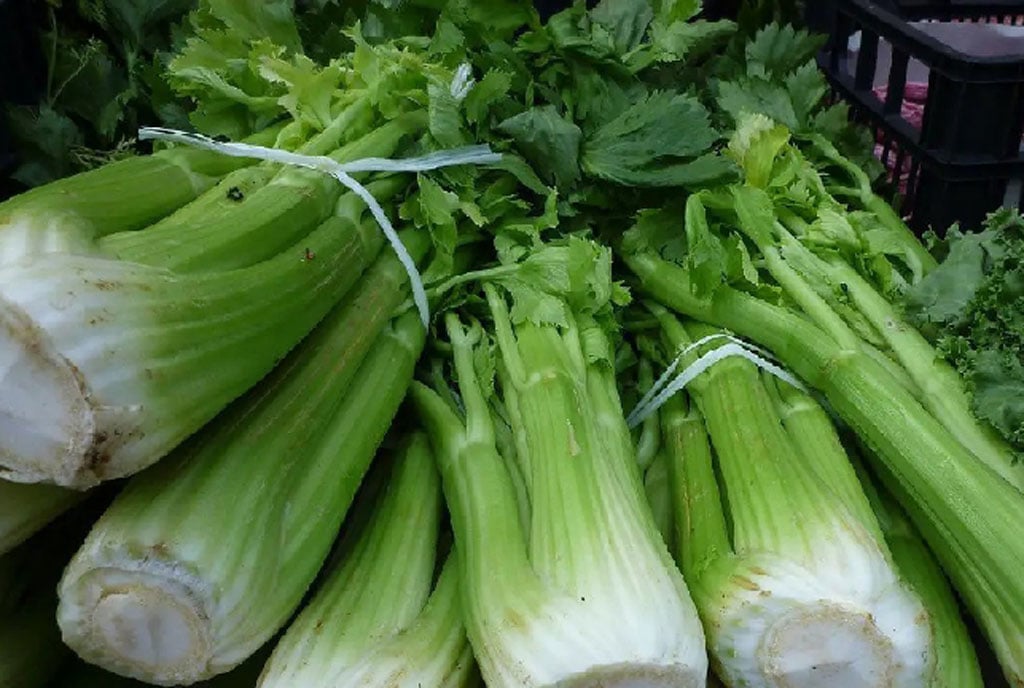Prime
Planting celery from sowing to harvest

Celery on display. A kilogramme of celery costs Shs5,000. PHOTO/FILE
What you need to know:
- When preparing your nursery seedbed, mix the soil with compost manure rich in nitrogen. Target a seed rate of about 450 grammes per hectare you intend to farm.
- You should then sow the seeds and lightly cover them.
Celery is a biennial plant that is farmed as an annual plant. Grown for its stalks, leaves, and seeds, the demand for celery in Uganda and East Africa as a region is increasing as more people become health conscious. It is rich in folic acid, vitamin B6, vitamin K, vitamin C, and potassium.
As a versatile plant, celery can be grown in farms, home gardens, and even in containers.
Health benefits
Celery is a sweet mild-green vegetable packed with nutrients and flavour especially when you cook it in soups. According to Julius Ahagaana, an agronomist, celery is packed with vitamins K and A and also contains traces of minerals such as calcium manganese and phosphorus.
“Being a vegetable, it also contains fiber which is essential in preventing constipation to avoid the horrific toilet dances we have all battled with at some point,” he says.
Market
The celery market is currently growing given people are more informed and are mindful of their diet. You can also farm your celery for its seeds for the extraction of essential oils for use mainly in the medical field. Fresh celery is currently retailing at Shs5,000 per kilogramme in Kampala supermarkets. You can also find it at Nakasero market.
Some of the major buyers of celery in include; diet and lifestyle restaurants, green groceries and export market among others.
Varieties
There are three major types of celery. These varieties are differentiated based on the part intended to be utilised for use.
In the broad category, there are two varieties; Leaf celery and stalk celery. The third variety is utilized for its roots. These varieties include;
“Celery root can be used as an ingredient in stews, salads, or a soup additive,” says Ahagaana.
Leaf celery is also referred to as ‘self-blanching’ or yellow celery. Its plants have leafy, slender, hollow petioles. It has a thinner stalk than Pascal and you can grow this variety for its aromatic leaves and seeds.
The third and most common type is the stalk celery. It takes 105-130 days to mature. It is consumed for its stalk and is eaten raw or in salads.
Ecological requirements
It is important to consider your farm properties before delving into celery farming. For the ideal growth of celery, certain ecological conditions have to be ideal.
Celery does well in slightly acidic soil of 6.0-6.8pH. Sandy to heavier loam soils rich in organic content is the most suitable for the production of celery. The soils should also be deep and well-drained.
Temperatures of about 15-250C is the most ideal for celery growth. Extended periods of cold temperatures below 130C will cause plant bolting. High temperatures of above 240C will result in the stalks becoming more fibrous and have a bitter taste.
Land preparation
When preparing land before you transplant your celery seedlings, you should take the following practices into consideration.
• You should select a site that receives direct sunlight.
• You should loosen the soil to a depth of about 30cm with a hoe.
• Since celery is a heavy feeder, it is also recommended that you mix well-rotted animal manure or compost to a depth of about 5cm. Make sure the soil is moist but not flooded.
• Ensure the soil is well drained. Any stagnant water in the field will encourage the spread of fungal diseases which will lead to unnecessary losses.
Fertiliser
Celery does well best in slightly acid soil (6.0-6.8pH). It is very important that you carry out a soil test analysis to know which nutrients your soil is deficient in for the growth of celery.
Celery has a high nitrogen requirement. The first application of nitrogen should be done at the time of planting time to boost root formation. About one month after transplanting, top dress with nitrogen fertiliser in the field and the remaining side is top dressed in the third month.
Nursery bed
When preparing your nursery seedbed, mix the soil with compost manure rich in nitrogen. Target a seed rate of about 450 grammes per hectare you intend to farm. You should then sow the seeds and lightly cover them. They will start germinating between four and eight weeks. You can soak the seeds in the water a day before sowing to hasten the germination process.
Celery seeds can also be directly sown into the field as long as you have a good irrigation system to ensure that the crop never goes without water. If you choose to use the seedbed method, your seedlings will be ready for transplanting after about two months after sowing.
Do not plant the seedlings too deep. Keep the roots of the plant to a depth of not more than 2cm.
Irrigation
Irrigation is key in all stages of the growth of the celery crop. During the preparation of the seedbed, you should ensure that the soil contains as much moisture as possible. You should also sprinkle some water lightly immediately after sowing. The surface should never become dry nor too wet (to allow for air circulation) until the seedlings appear.
Before transplanting, you should ensure the farm is adequately moist to ensure the transplanted seedlings do not suffer from water stress.




